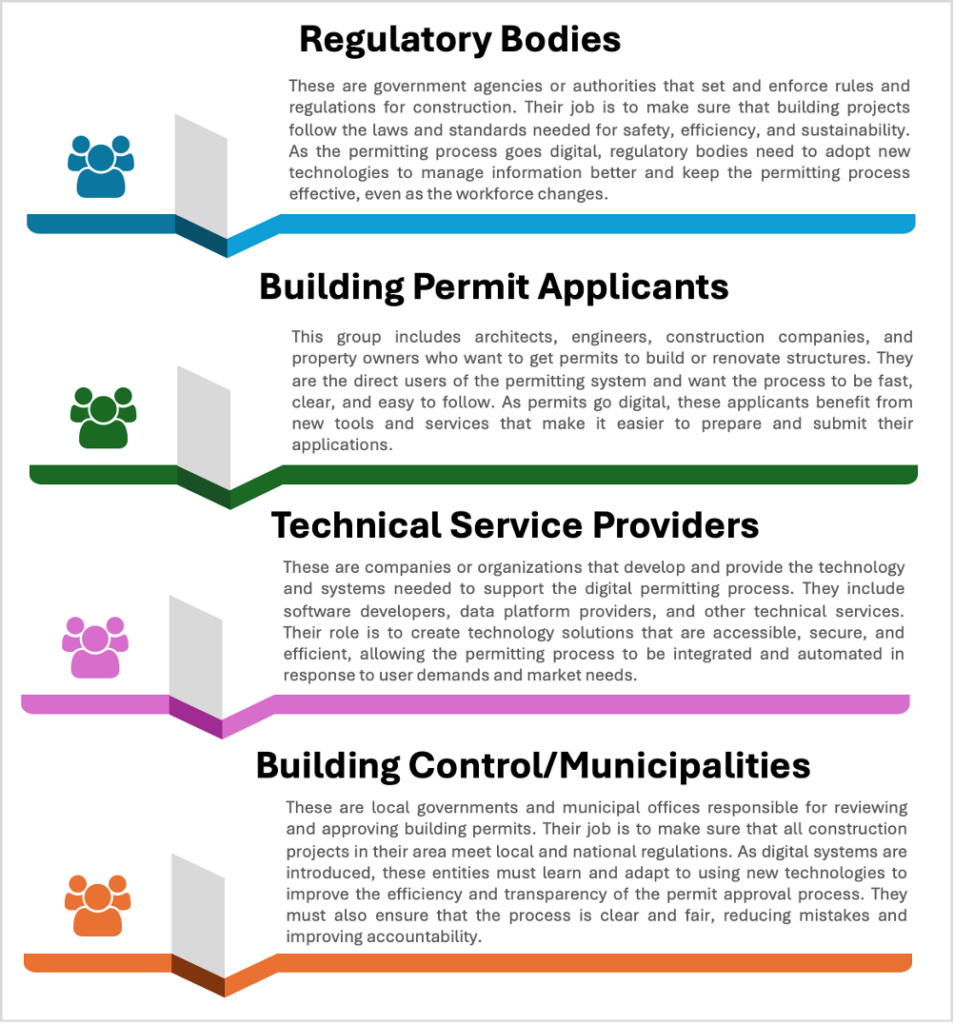Transformation Pathways towards Digital Permitting Processes in Demo Countries
In the digital age, automation and digitization are changing many industries, and construction is no exception. One of the most exciting developments in this area is the digitization of the building permit process. This change promises to make things more efficient, reduce costs, and increase transparency in the construction sector.
The ACCORD project, supported by Horizon Europe and UKRI, is leading this change in several pilot countries, including Finland, Germany, Estonia, the United Kingdom, and Spain. These countries are testing advanced digital processes for issuing building permits.
Traditionally, getting a building permit has been a slow and complicated process. But now, this system is experiencing a digital revolution. The goal is to create a more efficient, transparent, and accessible system that benefits not only the authorities but also the people applying for permits and the construction industry.
ACCORD's research focuses on finding ways to improve and digitalize the building permit process for the future. The project aims to develop better systems in the pilot countries and eventually across Europe.
This transformation plan has several key goals:
- To design and formalize a future digital process for building permits, including data, tools, and all the important players.
- To suggest improvements and create pathways to advance the digitization of permit processes in the pilot countries.
- To explore how to secure stored data using authentication technologies.
- To provide recommendations for standardization or regulation, helping to meet EU goals and the Built4People partnership agenda.
With these efforts, ACCORD is laying the groundwork for a future where getting a building permit is faster, safer, and more accessible for everyone, making a big step forward in the digitalization of the construction sector in Europe.
Methodology
In order to formulate a future reference process, a methodological approach has been chosen taking into account the user perspective: architects, authorities and applicants for civil building construction permits.
The methodology involves modelling the to-be reference process based on the as-is processes, the ACCORD semantic framework, user requirements and lessons learned from the demos, and developing a transformation matrix tool to analyse the actions needed for each country.
To this end, the ACCORD project has developed a transformation pathway matrix that can help to understand what each demonstration country needs to do to move forward in digital building permit processes.
The steps taken to develop and apply the transformation matrix in the demonstrations are as follows
First step: Existing transformation models and matrices
A number of existing transformation maturity models and matrices from ACCORD's sister projects supporting the digitisation of building permit processes are identified and used as a starting point, such as:
- CHEK has developed a maturity model that helps building authorities and other organisations assess the maturity of their organisations when implementing a digital building permit process. Organisations can assess their maturity level, identify capability gaps and create a roadmap for improving their processes, organisation, technology and information systems.
- EUnet4DBP The European Network for Digital Building Permits (EUnet4DBP) considers a roadmap (transformation model) as one of the key requirements for a fully digital building permit process. The roadmap is still under development, but other key requirements for digital building permit processes have been identified: a digital mindset of public officials, machine-interpretable regulatory text and building codes, building permit process enabling the use of various types of data, understanding of the process steps, alignment across Europe, standardisation, common dictionaries, modelling conventions and guidelines, and finally interoperability and APIs.
- BuildingSMART regulatory room also lists four levels (the second and third are combined) in its maturity map for the BIM-based building permit process. BuildingSMART International also offers a BIM maturity tool to assess organisations’ maturity in BIM adoption.
Second step: ACCORD transformation matrix elements
The next phase was to decide on other matrix elements needed for ACCORD purposes. It was decided that the transformation pathway would be defined from the key stakeholders' point of view:
The matrix would also include subjects in transition, needed resources, drivers, and activities needed to move from one maturity level to the next one.
Third step: Validation of the transformation matrix
The transformation matrix tool was validated in an ACCORD internal workshop held in Barcelona on April 16, 2024.
Fourt step: Matrix application in the country demos
Finally, the transformation matrix will be used as a tool to analyse the actions needed in each pilot country to reach the next maturity level.

Digital building permit maturity levels
In the fall of 2024, a national workshop will be organised in each pilot country to prioritise transformation actions in the short (2025), medium (2027), and long term (2030) to reach the next maturity level.

Today, the transformation pathway towards digital building permits has only been detailed for Finland.
Finland on the Path to Automating Building Permits
Finland is at the “digital” level but is moving towards the next levels: automated and even advanced. At these levels, BIM (Building Information Modeling) and GIS (Geographic Information Systems) are integrated, and building permit designs are submitted in IFC format, allowing semi-automated compliance checks. Currently, about 83% of Finland's 309 municipalities use an online building permit service. Finland has two online services that allow IFC submissions and digital neighbour consultations. If the architect has correctly modelled the BIM, project-specific data can be automatically read from IFC into the permit service and added to the application. Some municipal authorities use BIM software to review IFC files manually, but only a few municipalities use Solibri to perform semi-automatic checks, such as for accessibility. Automation allows authorities to spend more time on value-adding activities.

Finland's Long-Term Vision
Finland's long-term vision is to have digital building data that supports informed decision-making. This vision includes feedback loops and "situation pictures" during the digital and partially automated permitting process. Digital platform services, modelling for compliance checks (permitBIM), and automated code-compliance checks (ACCC) services will be key to making this process work. Each group involved in the process has its own long-term vision, aligned with Finland's overall vision.
- For policymakers, the long-term vision at the "advanced" maturity level is to have building regulations and codes updated into a format that allows machine-readable rules, with rules archive in place. Policymakers should also have a clear national picture of the built environment and assets through information databases and systems.
- For building permit applicants, the long-term vision is to have a service business based on digital information management, including BIM authoring tools and compliance-checking tools with visual reports.
- For technology service providers, the long-term vision is to have machine-readable rules defined for several use cases. The online building permitting platform should transform into a more service-oriented platform, with interfaces between municipal information systems and national built environment systems. AI could provide permit decision suggestions, and feedback loops would help learn from previous projects.
- For municipalities, the long-term vision is to have automated code compliance checking implemented in all permit authority units. Data transfer from municipal services to national services should be enabled. AI-driven feedback loops between projects should support learning and improve the quality of permit decisions.

Key Recommendations to Achieve the "Advanced" Maturity Level
To reach this long-term vision, several specific recommendations are made for each group:
- Policymakers should focus on two main goals:
- Update building regulations and codes into a format that allows machine-readable rules. This includes creating a shared national strategy, running research and development programs for rulemaking and improving information systems and their interfaces. Long-term adaptation through training and service development in municipalities is also important.
- Ensure a clear national view of the built environment by using and archiving IFC-based designs. They should further develop the National Built Environment Information System to support sustainable decision-making.
- Building permit applicants, building owners, and chief architects should:
- Align BIM laws and regulations with their strategies and develop internal processes that match the best permitting practices.
- Participate in creating new BIM-based building permit guidelines and offer pilot projects to help develop compliance-checking software.
- Technology service providers should focus on four key areas:
- Define machine-readable rules and create a plan for permitting platform services.
- Develop user-friendly interfaces and automated compliance-checking tools, integrating them into the permit service platform.
- Establish interfaces between municipal and national systems to improve information flow.
- Plan for using AI in compliance checks and run pilot projects to implement it.
- Municipalities should:
- Build the necessary skills to implement automated checks in all permit authority units.
- Enable data transfer from municipal services to national systems.
- Use AI transparently to support decision-making and continuous learning through feedback loops.
These recommendations are essential for Finland to achieve its vision of a digital, efficient building permit process that meets future needs.
Conclusion
Across Europe, a transformation towards automatic verification of building compliance is underway. Four main groups are involved in this process: policymakers (governments), building permit applicants, technology providers and municipalities. All of them need support and collaboration to make the transformation a success.
In order to achieve the digitisation of building permit processes in Europe, country-specific transformation pathways need to be designed and executed proactively to drive the change. The transformation matrix created in ACCORD can be used to plan the necessary steps to move from a traditional to a digital system. This matrix supports identifying what levels of development need to be achieved, what resources are needed and what actions need to be taken by the different actors involved, such as governments, permit applicants, technology providers and municipalities.
This tool is being tested and used in national workshops, where short, medium and long term actions will be prioritised for each country participating in the project.
Thanks to these efforts, it will be possible to propose improvements and clear routes to advance the digitisation of construction permit processes in these countries.
In addition, key actions will be proposed for governments, which play a key role in this change, to drive and accelerate this transition. To achieve this, the actions to be taken fall into three main categories: Strategic actions (planning and policies), Adaptive actions (adjustments and improvements) and Technical actions (technology implementation).
With these efforts underway, we hope to see concrete results that will allow us to move towards a future where building permits are more efficient, transparent and accessible to all.

